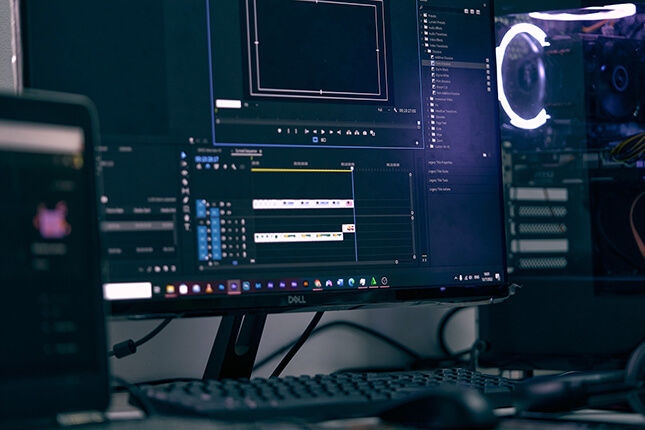What’s the Difference Between HD and 4K Video Production?
In the field of video production, the distinction between Full HD (1080p) and Ultra HD (2160p) has become increasingly crucial. Both formats have distinct advantages and applications, but recognizing the distinctions is critical for making informed judgments in the realm of video production. This article explores the distinctions between Full HD and Ultra HD video production, covering technology, visual quality, and future implications.
Technical Aspects: Resolution and Pixels
The primary distinction between Full HD (1080p) and 4K video creation is in their resolutions. The number of pixels that comprise a video frame is referred to as resolution. In Full HD, the resolution is typically 1920×1080 pixels, which amounts to 2.1 megapixels per frame. 4K, on the other hand, has a resolution of 3840×2160 pixels, which equates to a stunning 8.3 megapixels per frame. This massive increase in pixel count is what gives 4K its astounding clarity and detail.
The difference in resolution is stark. 4K offers four times the number of pixels compared to HD, resulting in sharper images and finer details. This heightened resolution is particularly valuable when producing content for larger screens or when the video will be viewed up close, such as in theaters or on 4K televisions.

Visual Quality: Sharpness and Detail
The primary benefit of 4K video production is the remarkable improvement in visual quality. The increased resolution means that each frame is crammed with more detail and sharpness, which can be especially noticeable on larger screens. With 4K, you can capture the subtle nuances in textures, colors, and fine lines that might be lost in an HD production.
4K also excels in providing a more immersive viewing experience. The increased resolution enhances realism, making it ideal for applications like nature documentaries, where every leaf, feather, or scale is on full display. Additionally, 4K’s superior image quality helps reduce the appearance of jagged edges and pixelation, which can occur when scaling or zooming in on HD footage.
However, it’s essential to note that the improvement in visual quality is most noticeable when viewed on a 4K display. On an HD screen, 4K footage will still look good but won’t reach its full potential. This is an important consideration, as the majority of viewers may not yet own 4K televisions or monitors.
Practical Uses: Versatility and Future-Proofing
Despite the remarkable improvement in visual quality offered by 4K, HD remains a practical choice for many applications. The choice between the two formats depends on the project’s specific goals and budget constraints.

HD Video Production:
- Cost-Effective: HD video production is generally more affordable than 4K. This can be a significant advantage for smaller productions or projects with limited budgets.
- Widespread Compatibility: HD content is still widely used and accepted. It’s suitable for various distribution platforms, including television, streaming services, and online platforms like YouTube.
- Faster Editing and Rendering: HD video files are smaller and less demanding on computer hardware, making editing and rendering processes faster and more efficient.
4K Video Production:
- Enhanced Quality: 4K excels when the highest visual quality is paramount. It’s the go-to choice for filmmakers, documentarians, and advertisers looking to make a strong visual impact.
- Future-Proofing: As 4K displays become more common, producing content in 4K can future-proof your work. This means your content will look its best as technology advances and more viewers adopt 4K screens.
- Flexibility in Post-Production: Shooting in 4K allows for greater flexibility in post-production. You can crop, zoom, and stabilize footage while maintaining high quality.
Storage and Data Considerations
One significant practical aspect to consider when deciding between HD and 4K is the impact on storage and data management.
For 4K video production, it’s essential to note that video files are significantly larger than their HD counterparts. This means you’ll require more storage space to save your footage, and you’ll also need more powerful hardware for video editing and rendering. Additionally, 4K video requires a faster data transfer rate when working with high-quality footage, which may necessitate investing in specialized equipment.
Furthermore, shooting in 4K consumes more power, so battery life can be a concern for filmmakers working in remote locations or without easy access to power sources. These technical requirements and considerations can add to the overall cost of 4K production.
In contrast, HD video production is less demanding in terms of storage, data transfer, and power consumption. This makes it a more practical choice for projects with limited resources or tight schedules.

The Future of Video Production
In conclusion, the future of video production undoubtedly leans towards higher resolutions, including 4K and beyond. As technology continues to advance, 4K displays will become more prevalent, and resolutions such as 8K will emerge as new standards, pushing the boundaries of visual quality and realism in video production.
However, this transition will not happen overnight. HD content will remain relevant, particularly in situations prioritizing budget or practicality over resolution. The adoption of 4K will vary based on region and industry, highlighting the importance of considering audience and project needs.
Both HD and 4K formats have their merits, and the choice depends on your project’s goals, budget, and target audience. As technology evolves, the shift towards higher resolutions like 4K will continue, but HD will remain a viable and cost-effective option for various applications in the world of video production.
Lasting Blueprint Can Help You Create Your Next Video Masterpiece
Whether you need HD or 4K capabilities, having the correct tools and equipment at your disposal is critical to success. Lasting Blueprint Productions provides a wide choice of equipment and trained videographers in Orlando to help you create your next masterpiece. With over a decade of video production experience, our Orlando video production company is well-equipped to handle your organization’s videography demands.


